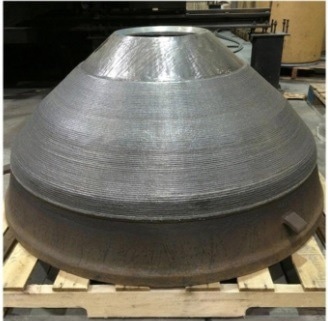Wear is one of the most challenging issues faced by heavy industry. In mining alone, 17% of the consumed energy is used to combat wear failure, which accounts for 2.7% of worldwide CO2 emissions.
Welding highly alloyed consumables onto the surfaces of components is one of the most common methods to combat wear. These alloyed consumables are required to meet stringent cost, safety, performance ,and environmental impact requirements.
A complex interaction of properties determines wear performance, which makes optimizing cost/benefit for hardfacing materials difficult.
This case study describes the process of the Welding Alloys Group (WAG) as it applied machine learning to this problem, resulting in the development of an improved hardfacing material; not only from a cost/benefit and performance perspective but also from an environmental point of view.
Wear is a very complex phenomenon that causes many challenges within heavy industry. The common and misleading conception is that high hardness secures high wear-resistant properties. In fact, a complex interaction of the chemical and mechanical properties of every material involved in the application defines optimum wear resistance. Composition, toughness, hardness, Young's modulus, grain size, and phase composition all impact wear, while external parameters such as pressure, temperature, and humidity also play critical roles.

Image Credit: Intellegens Limited
Finished products with significant discrepancies in performance result from random and systematic variations on wires and hardfacing welding procedures. Due to excessive use of highly polluting Chromium (Cr), environmental costs are also a significant concern, as are the increasingly-strict environmental regulations that push for lean welding consumables.
The primary goal of this project was to take one high-Cr cast iron-based welding consumable and, based on the performance metric of abrasion-resistant standard methods, optimize cost/benefit as a function of chemical composition by use of the Alchemite™ machine learning toolkit.
Intellegens' unique deep learning tool, Alchemite™, builds comprehensive models across multiple material properties and compositions from sparse experimental data using the power of deep neural networks.
Composition and physical property data from the literature, as well as historical data from WAG, was used to construct the model for hardfacing materials. The measure of resistance to wear was weight loss.
Methodology
Step 1:
The most influential performance parameters were defined by Alchemite™, which suggested the first round of theoretical compositions. Manufacturing was confirmed and approved by WAG engineers.
Step 2:
Against predicted values, formulations were manufactured, tested, and validated. This analysis showed acceptable agreement and fell within the calculated uncertainty.
Step 3:
The model was refined by carrying out additional iterations.
Step 4:
A new formulation was defined. Laboratory tests showed comparable performance to existing products, but with a reduction of 50% of alloy elements and a price reduction of between 10-15%.
Key Outcomes
- Predictions were experimentally validated. There was a considerable difference between compositions selected for validation and existing materials. These new materials significantly improved the model.
- Alchemite™ proposed a more cost-efficient and environmentally-friendly alternative to modern hardfacing material.
- This material has been taken forward by WAG to industrial-scale performance trials.
Future Opportunities
This outcome represents a significant step forward for Welding Alloys Group. Successful progress toward using state-of-the-art computational methods for designing new welding consumables and improving existing consumables has been shown. This approach, therefore, continues for other ranges of welding consumables.
About Welding Alloys Group
Welding Alloys Group is strongly committed to creating and maintaining close customer relationships as the go-to provider for automated equipment for wear protection, advanced welding consumables, and engineered wear solutions. It has obtained numerous firm industry partnerships as a total solution supplier – from integrated engineering solutions to consumables and machines.
About Intellegens
Alchemite™, the unique deep learning engine, has been developed by Intellegens for training neural networks with noisy and sparse data typical of real-world science and business challenges.
First developed at the University of Cambridge, the technology has been used to guide the design of new drugs, develop aerospace alloys, and design next-generation battery technology. Optimizing products and processes, saving time and cost in discovery and development, and enabling breakthrough insights, the tool is now being deployed to solve various industrial customer issues.
References
- Global energy consumption due to friction and wear in the mining industry. Tribology International. Volume 115, November 2017, Pages 116-139

This information has been sourced, reviewed and adapted from materials provided by Intellegens Limited.
For more information on this source, please visit Intellegens Limited.